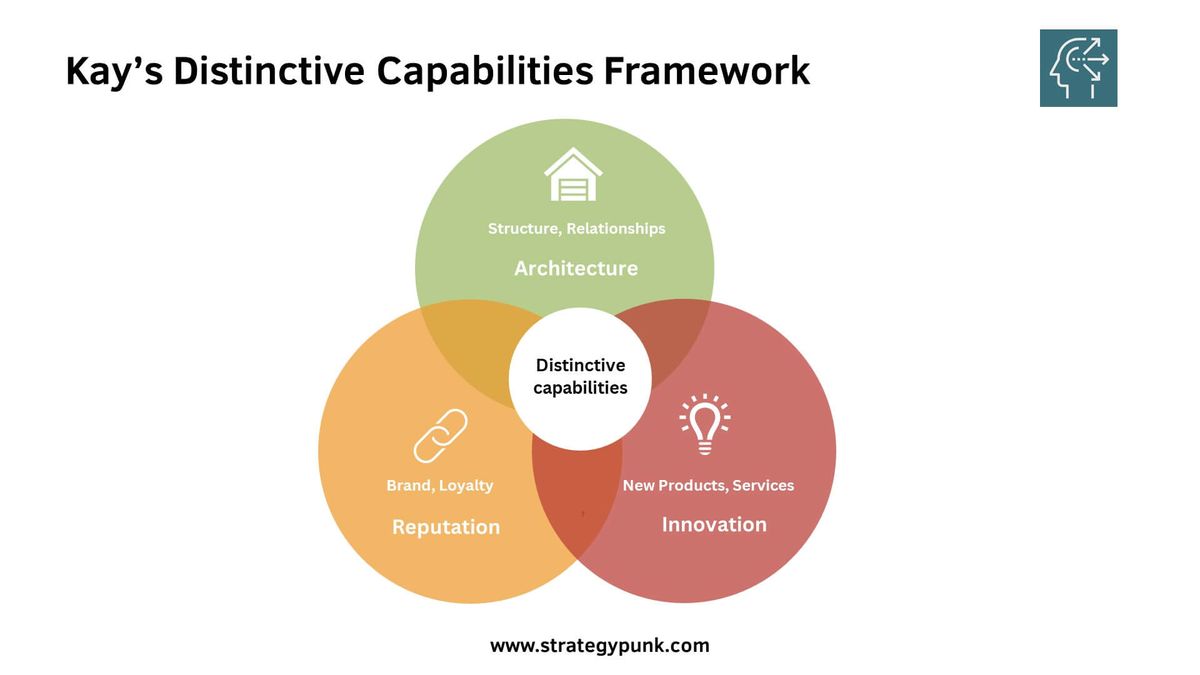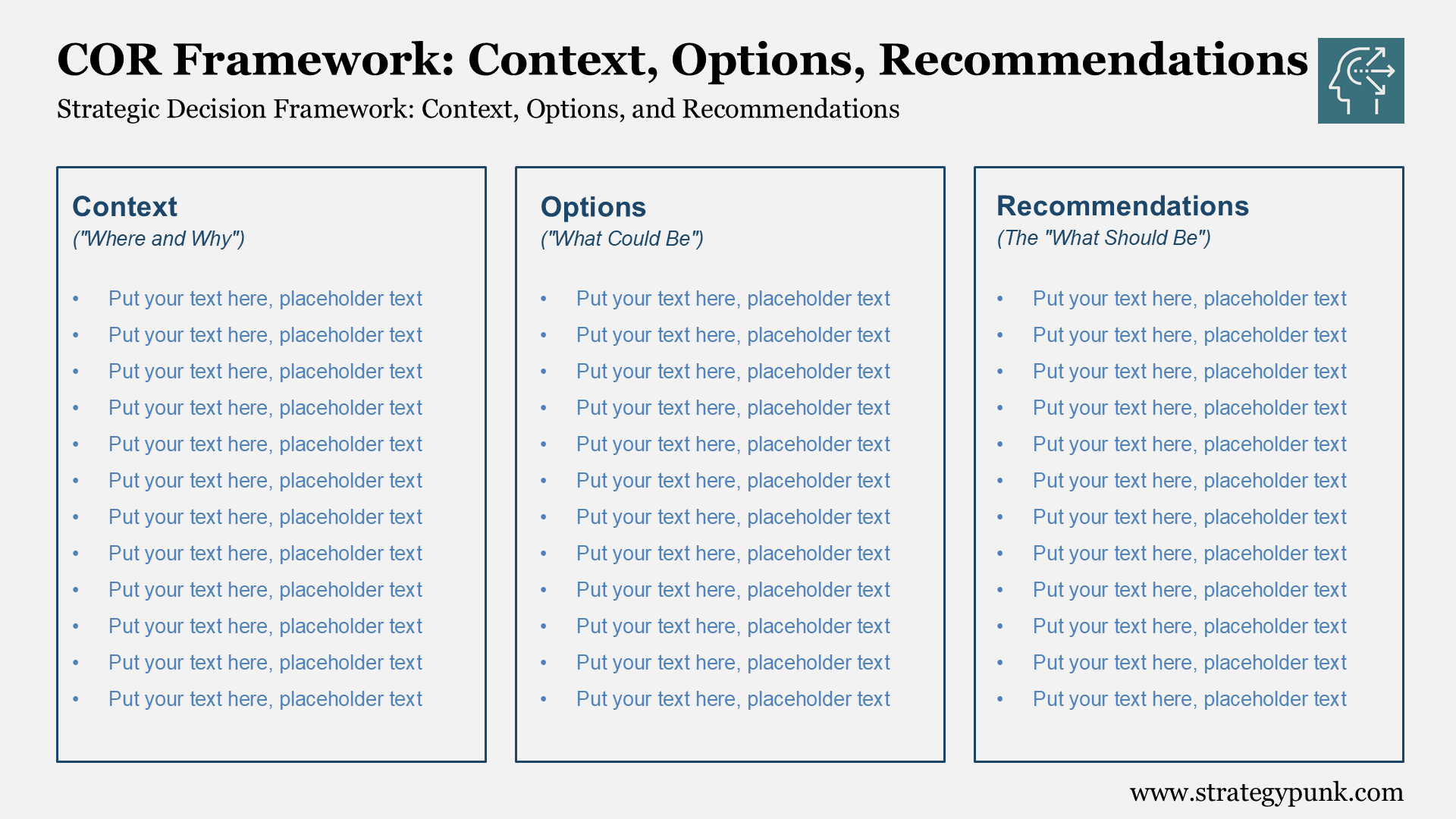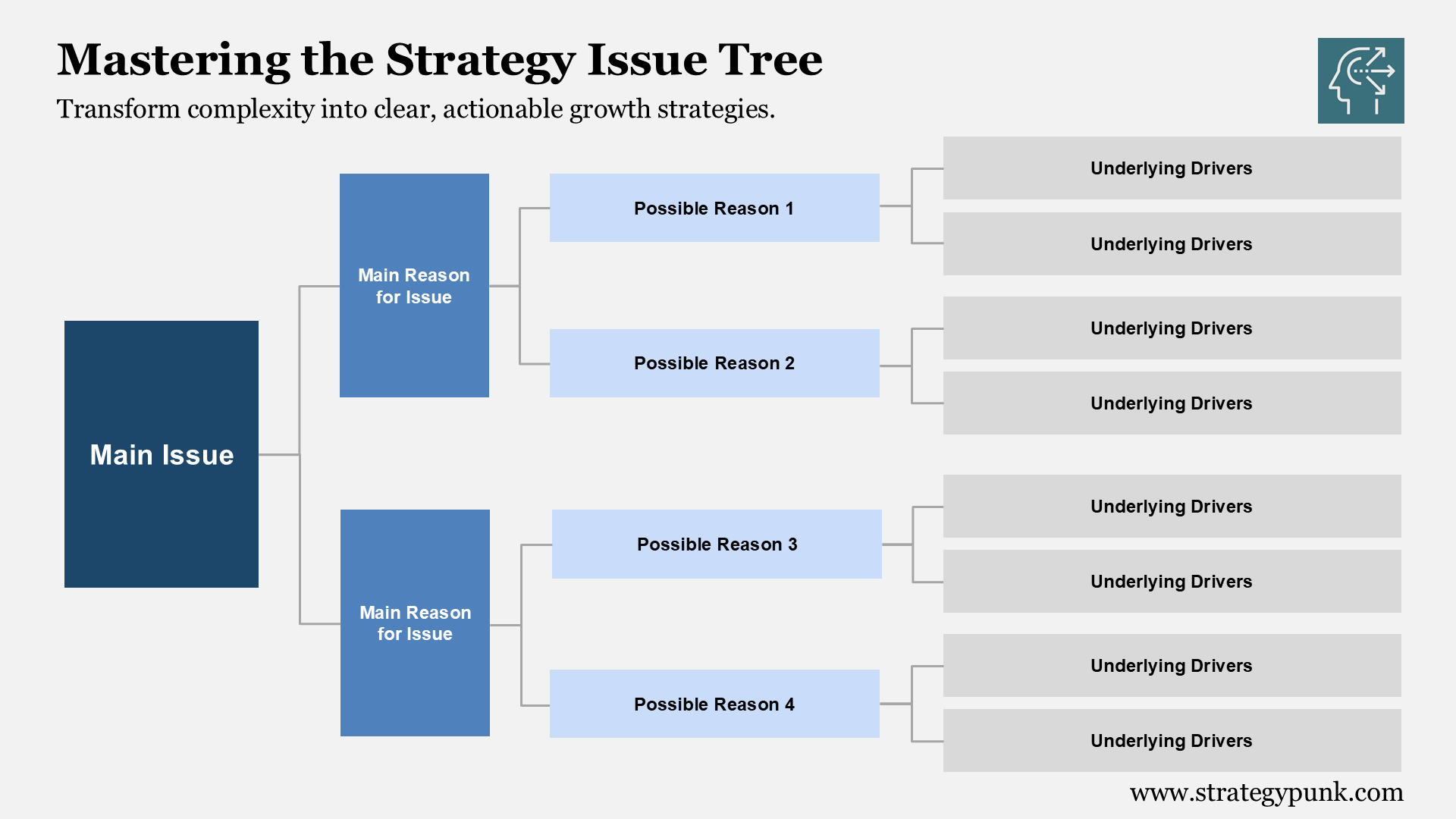The Power of Distinction: Applying Kay's Distinctive Capabilities Framework (Free PPT)
This blog post delves into John Kay's renowned Distinctive Capabilities Framework, a tool crucial for businesses seeking a competitive edge. Kay's framework focuses on three core capabilities: architecture, reputation, and innovation. Download our free and fully editable PowerPoint Template.

Introduction to Kay's Distinctive Capabilities Framework
Kay's Distinctive Capabilities Framework was developed in the 1990s by John Kay, a professor of economics at the London Business School.
The framework identifies three critical organizational capabilities that can give a company a competitive advantage if leveraged effectively: architecture, reputation, and innovation1.
Overview of the Framework
According to Kay's framework, architecture refers to a company's organizational structure and relationships. This includes corporate culture, partnerships, supplier relationships, distribution channels, and interactions with customers and employees2.
An efficient architecture allows the smooth transfer of information within the company and with external stakeholders. It also enables quick and flexible responses to changing market conditions.
Reputation is how a company is viewed by its customers, partners, and the general public. Reputation depends on consistently delivering high-quality products and services. Effective marketing and advertising builds reputation, as does honoring warranties and providing good customer service.
Innovation means developing new or improved products, services, processes, and business models. Staying innovative attracts and retains customers by ensuring the company stays relevant in changing markets. However, innovation is often complex to sustain long-term, so it is sometimes used to establish a reputation or architecture initially.
According to Kay, these three capabilities are difficult for competitors to imitate or replicate. So, if leveraged effectively, they can provide a lasting competitive advantage. This contrasts with other strategy frameworks focusing more on controlling strategic assets or resources.
What are the three types of distinctive capabilities?
John Kay's framework identifies three key distinctive capabilities:
Architecture
This is about a company's network of relationships, both inside with employees and outside with suppliers, customers, and sometimes even competitors. Good architecture helps a company adapt quickly and work efficiently as a team.
Reputation
This deals with how others see the company. A strong reputation, built through consistent quality and good service, earns customer loyalty and differentiates the company from competitors.
Innovation
This is the company's ability to develop new products, services, or business methods. It's not just about technology but also about creative problem-solving and staying ahead of market trends.
These capabilities are vital for a company's long-term success because they are hard for others to copy and give a lasting competitive edge.
Differences Between Distinctive and Non-Distinctive Capabilities
Kay makes a distinction between distinctive capabilities that provide strategic differentiation and non-distinctive capabilities that are more commonplace:
Distinctive Capabilities
- Unique to the company
- It is hard for competitors to imitate
- Source of competitive advantage
- Examples: reputation, innovation, architecture
Non-Distinctive Capabilities
- Not unique to the company
- Easily imitated by competitors
- Necessary but not a competitive differentiator
- Examples: product quality, marketing, cost efficiencies
While non-distinctive capabilities are still crucial for any company to master, they can be replicated by competitors relatively easily. Distinctive capabilities are what set a company apart in its marketplace positioning.
Applying the Kay's Distinctive Capabilities Framework

There are a few key steps companies can take to apply Kay's Distinctive Capabilities Framework:
- Identify strategic objectives and target markets
- Analyze which of the three capabilities (architecture, reputation, innovation) best support the strategy and business relationships
- Assess existing organizational capabilities and determine which are genuinely distinctive
- Develop and leverage the distinctive capabilities as core differentiators
- Enhance supportive non-distinctive capabilities as needed
- Continuously improve and sustain the distinctive capabilities over the long term
The framework forces executives to think carefully about what makes their company unique. This focuses on strategic planning and helps allocate resources more effectively.
Kay's Distinctive Capabilities Framework - Apple Example
Apple provides an excellent example of effectively leveraging distinctive capabilities:
- Architecture: Strong corporate culture focused on simplicity and design. Close supplier relationships to control component quality. Controlled customer experience through Apple stores.
- Reputation: Brand identity built on innovation, ease of use, and premium aesthetics. Loyal customer base willing to pay more.
- Innovation: Revolutionary products like the iPod, iPhone, and iPad. Seamless software and hardware integration.
While competitors can replicate elements like Apple's supply chain or retail stores, it is tough to recreate Apple's distinctive capabilities. The company continues to leverage these capabilities to maintain its competitive positioning.
Summing Up
Kay's Distinctive Capabilities Framework emphasizes leveraging your company's unique capabilities to gain a competitive advantage.
By focusing strategy on developing architecture, reputation, and innovation, companies can establish differentiation that is hard for competitors to replicate.
Executives should assess their existing capabilities and determine which sets the company apart in the marketplace. Although simple, this framework provides powerful guidance for establishing competitive positioning and strategy.
Frequently Asked Questions
on Kay's Distinctive Capabilities Framework
How can a company identify its non-distinctive capabilities?
Here are a few ways a company can identify its non-distinctive capabilities:
- Conduct a capability analysis to map all organizational capabilities. Distinguish between capabilities that provide strategic differentiation (distinctive) versus more common capabilities (non-distinctive).
- Review competitive offerings and marketing messaging. Identify capabilities multiple competitors promote, indicating they are not rare or specialized. These are likely non-distinctive.
- Analyze past strategic plans and documents. Capabilities referenced as "table stakes" or "minimum requirements" are often non-distinctive.
- Interview employees across the organization. Ask them to identify capabilities that they believe are common across the industry versus specialized within the company.
- Assess the difficulty of replicating capabilities. Those that competitors could easily copy within a short timeframe are generally non-distinctive.
- Consider the value created by each capability. Those that do not directly contribute to competitive advantage or support the core business model are less likely to be distinctive.
- Examine costs associated with capabilities. Those with minimal investment that is easy to maintain are less scarce or specialized, hence non-distinctive.
- Review industry reports and competitive benchmarking. Capabilities that many players possess are non-distinctive.
- Consult with customers and suppliers. Ask what they view as standard capabilities versus differentiated strengths.
The goal is to systematically distinguish between standard and specialized capabilities across all business functions and units. This helps focus strategy on leveraging truly distinctive strengths.
How can a company differentiate between distinctive and non-distinctive capabilities
Here are the critical differences between specific and non-distinctive capabilities:
Distinctive Capabilities
- Unique to the company and challenging for competitors to imitate
- Source of competitive advantage and strategic differentiation
- Examples include reputation, innovation, organizational architecture
- Create value and allow the company to charge premium prices
Non-Distinctive Capabilities
- Not unique and easily replicated by competitors
- Necessary but do not provide differentiation
- Examples include product quality, marketing, cost efficiencies
- More "table stakes" - minimum requirements to compete
Companies should focus their strategy on leveraging distinctive capabilities, as these are lasting sources of competitive advantage.
Non-distinctive capabilities are still critical operationally but do not confer strategic differentiation. To identify distinctive capabilities, companies can conduct capability analysis, examine past strategy documents, interview employees, assess replicability, and consult with customers and suppliers.
The goal is to distinguish familiar vs specialized capabilities across the organization.
What are some examples of distinctive capabilities in a company?
Here are some examples of distinctive capabilities that can provide a competitive advantage for a company:
- Innovation - Ability to consistently develop new and improved products, services, or business models ahead of competitors. Examples include Apple's design, hardware and software integration, and Amazon's logistics network.
- Brand reputation - Strong brand identity, customer loyalty, and willingness to pay a premium price. Luxury fashion houses like Louis Vuitton have built distinctive brand reputations.
- Organizational culture - Shared mindset, values, and practices that enhance productivity, creativity, or customer service. Companies like Southwest Airlines and Zappos have famously strong cultures.
- Talent - Skilled workforce with unique capabilities that are hard to replicate. Pixar's creative animation talent is a distinctive capability.
- Customer service - Providing an exceptionally positive customer experience compared to competitors. Companies like Nordstrom and Ritz Carlton are known for superior service.
- Technology - Proprietary systems, methods, or algorithms that improve operations, analytics, or decision-making. Google's search algorithms are a distinctive technical capability.
- Distribution network - Logistics infrastructure for delivering products/services more efficiently. Amazon's distribution capabilities allow fast, low-cost delivery.
The key is that these capabilities are difficult for competitors to imitate. They enable unique value creation that strengthens the company's competitive positioning over the long term.
What is the definition of Kay architecture?
Kay's architecture is an organizational strategy concept that emphasizes the unique structure and network of relationships within a company and between the company and its suppliers and customers.
It focuses on creating a competitive advantage by developing distinctive capabilities through these complex and often implicit relationships, differing from traditional strategies like cost leadership or differentiation.
This approach involves critically examining a company's organizational structure and key relationships to identify and leverage unique aspects for strategic advantage.
Kay's Distinctive Capabilities Framework PowerPoint Template
free and fully editable slide deck
To help explain Kay's Distinctive Capabilities Framework, you can download the following free PowerPoint template:
This template provides an overview of the framework and its key components. It also includes a comparison of distinctive vs. non-distinctive capabilities.
The slides are fully editable so that you can customize them for your presentation needs.


Kay's Distinctive Capabilities Framework - Slide Deck
Log-In and Download Kay's Distinctive Capabilities Framework Free PDF and PowerPoint Template





